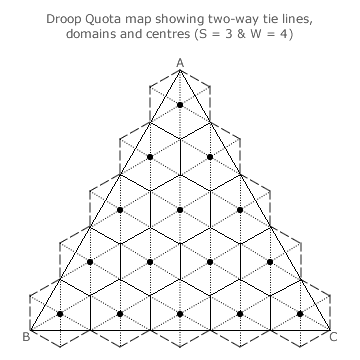Comparisons: Droop Quota ~ Proportionality 1
Disproportionality Indices

For party-list CHPV, the Gallagher or Least Squares Index (LSI) is employed as a measure of the discrepancy between the party shares of the tallies (t) and the party shares of the seats (s); where 0 ≤ LSI ≤ 1. If necessary, please refer back to the Evaluations: Proportionality of CHPV section. For convenience, the definition of the least squares index for S parties is repeated here; see opposite.
To facilitate a fair comparison with CHPV, the proportionality of the Droop Quota is approached in an identical manner. Two LSIs are again employed to assess disproportionality; one for the seat resolution and the other for the voting system itself. The resolution LSI is based on the discrepancies between the centres and the corners or extremes of the domains. These domains relate to those of an optimally proportional voting (OPV) system. For a given number of parties (S) and seats (W), the number and average size of the domains are identical irrespective of the voting system used. Hence, the resolution LSI is almost identical for OPV, CHPV and the Droop Quota.

By separating the common discrepancies due to resolution from the unique ones introduced by the voting system itself, a clearer comparison between two rival systems can be achieved. The voting system least squares index (LSIVS) is also repeated here; see opposite. For a given election (S and W), there are k domains in total and each domain j requires its own LSI to be determined.
The centre of an OPV domain is where perfect party proportionality is achieved between tallies and seats. Like CHPV, the centre of the corresponding Droop Quota domain will be offset from this ideal point. The least squares index for domain j (LSIj) hence measures the disproportionality introduced by the Droop Quota algorithm in offsetting its domain centre. The overall LSIVS simply combines these individual domain LSIs into one value within, as always, the range 0 ≤ LSI ≤ 1.
Droop Quota Domain Centres

In order to determine the LSIVS for any particular party-list Droop Quota election, the position of each domain centre must first be identified. In the example three-party four-winner map opposite, all the fifteen domains and their centres are shown.
As seen in the earlier Droop Quota ~ Maps section, the three-party domains are all regular hexagons of identical size (before truncation). The domain boundaries within the map are shown as full lines and those truncated ones outside it as dashed lines.
The domain boundaries are the critically-tied sections of the two-way tie lines. The non-critically-tied sections are shown as dotted lines. The dot at the intersection of three non-critical two-way tie lines is also at the centre of that domain.
The dot at the intersection of these three lines represents a non-critical three-way tie between the parties. Such ties are non-critical because all the seats will have already been won with W out of the W+1 quotas being exceeded. In terms of seats, it is therefore irrelevant that the three parties have an equal one-third share of the one left-over quota.
However, these non-critical three-way ties are very useful in determining the party tally shares at the centre of every domain on the map. Where YZ is the number of seats won by party Z, the following formula is used to determine the per-unit shares of the tallies (t) at the centre of each domain.
- tZ = (YZ + 1/S)/(W + 1) for party Z
Note that for perfect proportionality, tZ = YZ/W = sZ where sZ is the per-unit share of the seats won by party Z.
Having established the location of every domain centre and the shares of the seats and tallies at each one, the voting system LSI for the Droop Quota can then easily be calculated.
Proceed to next page > Comparisons: Droop Quota ~ Proportionality 2
Return to previous page > Comparisons: Droop Quota ~ Party Cloning 2
